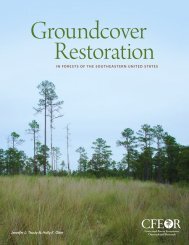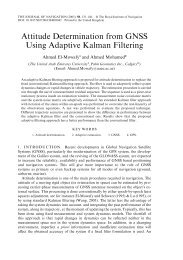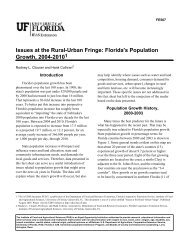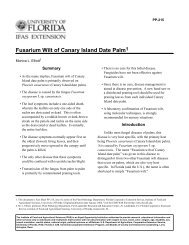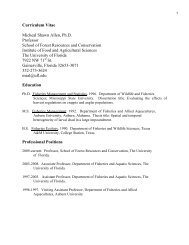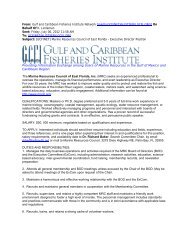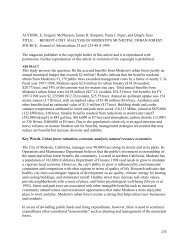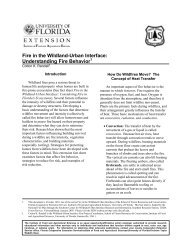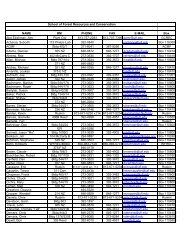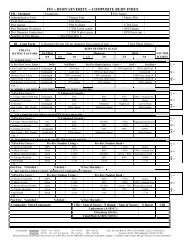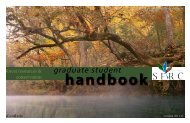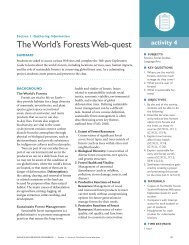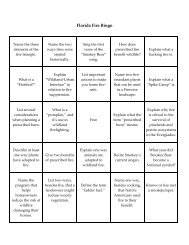Longleaf Pine Forest Restoration & Management - School of Forest ...
Longleaf Pine Forest Restoration & Management - School of Forest ...
Longleaf Pine Forest Restoration & Management - School of Forest ...
You also want an ePaper? Increase the reach of your titles
YUMPU automatically turns print PDFs into web optimized ePapers that Google loves.
<strong>Management</strong> Practices to Support Increased Biodiversity in Managed Loblolly <strong>Pine</strong>.... 3<br />
requires heavier thinning than for timber<br />
production, with a target <strong>of</strong> 50-70 ft 2 /acre <strong>of</strong><br />
residual basal area (Blair and Enghardt<br />
1976, Halls 1973, Van Lear et al. 2004). A<br />
residual basal area <strong>of</strong> 80 ft 2 /acre is usually<br />
considered a minimum for timber<br />
production and economic return (Siry 2002,<br />
Siry et al. 2001).<br />
A potential problem with thinning to open up the<br />
pine overstory is that it can allow understory<br />
hardwoods to develop into a dense midstory.<br />
Hardwoods produce heavy shade that inhibits<br />
understory vegetation. Thinning can also increase<br />
vines and shrubs, which further shade out the<br />
herbaceous layer. Thus, without controlling<br />
hardwoods and other woody vegetation, thinning can<br />
ultimately result in a less productive and less diverse<br />
understory (Blair and Feduccia 1977, Hunter 1990).<br />
A hardwood midstory can add vertical stratification<br />
and benefit some midstory-associated birds.<br />
However, a hardwood midstory is generally<br />
undesirable for most wildlife, including deer, small<br />
mammals, and other birds (Dickson 1982, Lohr et al.<br />
2002, Melchiors 1991, Wilson and Watts 1999).<br />
While a dense midstory is undesirable, some<br />
hardwoods are necessary for supporting biodiversity.<br />
Mature hardwoods such as oaks provide hard mast<br />
that is important for many wildlife species.<br />
Maintaining a desirable component <strong>of</strong> hardwoods can<br />
improve wildlife habitat (Tappe et al. 1993). When<br />
controlling hardwoods, it can be beneficial to select<br />
individual fruit- or mast-producing trees to retain. It<br />
is also very important to maintain some whole areas<br />
<strong>of</strong> hardwoods. An interspersion <strong>of</strong> hardwood and<br />
pine forest types provides good wildlife habitat<br />
(Shultz 1997). Hardwoods should especially be<br />
maintained in sensitive areas such as bottomlands and<br />
drainages. Hardwood maintenance should generally<br />
stay focused on hardwood sites.<br />
In intensively managed plantations, prescribed<br />
burning can be used in conjunction with thinning to<br />
achieve conditions that support increased<br />
biodiversity. In historic, natural pine stands, frequent<br />
low-intensity fires helped to control hardwoods and<br />
maintain an open stand structure with a productive<br />
and diverse understory. Frequent low-intensity fires<br />
tend to favor growth <strong>of</strong> herbaceous vegetation by<br />
suppressing hardwoods and other woody vegetation<br />
(Reed et al. 1994). Many <strong>of</strong> the plants and animals<br />
associated with southern pine communities are<br />
adapted to or even dependent on fire, and wildlife<br />
mortality from fire is generally very low (Landers<br />
1987, Means and Campbell 1981, Moorman 2002).<br />
Regular burning improves habitat for many species,<br />
including deer, quail, turkey, amphibians and reptiles,<br />
and Bachman's sparrow (Tucker et al. 1998). To help<br />
provide for a broad suite <strong>of</strong> species in the short and<br />
long term, areas should not be burned evenly; instead,<br />
leave patches <strong>of</strong> unburned areas to provide for<br />
nesting and cover.<br />
Prescribed burning is recommended when<br />
dominant pine trees are at least 15 feet tall.<br />
Recommended burning intervals range from 3-6<br />
years. Marion et al. (1986) suggest 3-5 years to allow<br />
enough time for browse and cover to develop, and for<br />
enough fuel to accumulate to carry the next fire.<br />
Historically, longleaf pine communities in Florida<br />
burned naturally every 2-5 years (Noss 1988).<br />
Prescribed burning should not be overdone, or the<br />
cumulative impacts could become negative in the<br />
long term. Burning every year, for example, can<br />
eliminate hardwoods altogether (Grano 1970), and<br />
complete loss <strong>of</strong> the hardwood component would<br />
greatly inhibit biodiversity.<br />
Winter prescribed burns are commonly<br />
recommended in pine plantations. Robbins and Myers<br />
(1992) note, however, that varying both the season<br />
and the frequency <strong>of</strong> burning avoids favoring only<br />
one suite <strong>of</strong> species. Adding this element <strong>of</strong><br />
variability can increase overall stand diversity.<br />
Coordinating burning with thinning is also important.<br />
Thinning increases the effectiveness <strong>of</strong> prescribed<br />
burning for wildlife (Hurst and Warren 1982,<br />
Melchiors 1991, Tucker et al. 1998). Burning before<br />
thinning can make thinning easier, and it avoids the<br />
problem <strong>of</strong> the fire burning too intensely in the slash<br />
from the thinned trees.<br />
An alternative to prescribed burning for the<br />
control <strong>of</strong> non-pine woody vegetation is to use<br />
herbicides (Dickson and Wigley 2001, Harrington<br />
and Edwards 1999). Herbicides can be less costly



